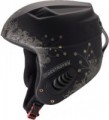Type
The type determines the category of users for which the helmet is designed.
-
Men. Helmets designed primarily for men. At the same time, the degree of specialization may vary: for example, some models are designed taking into account the structural features of the male head, while others differ from “unisex” only in marketing. And the design can be different - from strict or aggressive to completely neutral, suitable for the unisex category.
—
Women. Helmets designed specifically for a female audience. They differ from men's models primarily in their characteristic design (although not always - neutrally designed models are also found here). Also, women's equipment is produced in slightly smaller sizes, and manufacturers are trying to reduce weight - women's neck muscles are somewhat weaker than men of the same build. And other features of female anatomy (for example, narrower cheeks and a pointed chin) are also often taken into account in such models.
- Unisex. Helmets for adult riders, without a “gender” and positioned as equipment that is equally suitable for both men and women - both in construction and design. The design can be both restrained and bright.
-
Kids. Helmets designed for children and teenagers - that is, users who have not yet matured enough to wear adult equipment. They differ, first of all, in their reduced s
...ize and maximally reduced weight - to minimize the excess load on the child’s neck and spine. In addition, they often have a characteristic bright design and simplified functionality.
Note that the difference between the types of “adult” helmets is extremely arbitrary and often lies not so much in the design as in the appearance. Moreover, the same model can be produced in several colour options, including neutral, and frankly “masculine” or “feminine”. In such cases, the type is indicated by which options there are more.Size
Sizes in which this helmet model is available.
A suitable size is determined primarily by the circumference of the head at its widest point, at the level of a couple of centimetres above the eyebrows. Sizes are indicated everywhere as standard —
XXS,
XS,
S,
M,
L,
XL,
XXL, etc. However, these designations may correspond to different actual helmet sizes for different manufacturers. For example, size S for one brand may be designed for a head circumference of 56 cm, and another — for 52 – 54 cm. In addition, men's and women's helmets (see "Gender and age") of the same size may also differ. Therefore, to select a helmet that is suitable for head circumference, it is best to use special tables that take into account the points described above.
Also, note that helmets of the same size can differ markedly in internal shape and other features. Therefore, when choosing, you need to take into account not only the size, but also the actual convenience — the helmet should sit tightly on the head, but not compress it.
Goggle strap
The presence of a
clip for a ski mask in the design of the helmet.
This clip is usually found at the back of the helmet. It is designed to fix the mask strap — so that even if the mask flies off the head (for example, when an athlete falls), it will not fall or be lost. Accordingly, this feature is highly desirable when using a helmet with a separate mask (although the masks themselves are quite compatible with many helmets without clip).
Adjustable ventilation
The presence
of an adjustable ventilation system in the design of the helmet.
This adjustment is usually done by closing and opening the vent openings, sometimes with an intermediate, half-open position. In addition, some models allow you to separately close/open the front and rear openings. This allows you to customize the equipment to suit the situation. For example, in a frost or a snowstorm with a strong wind, ventilation can be covered so that snow does not fly into it or so that the head does not freeze; and when downhill it is better to leave open only the rear holes, for the same reasons.
Detachable lining
The presence of
a detachable lining in the helmet design.
The detachable lining practically does not affect the functionality and protective properties of the helmet — except that for “extreme” professional models it is considered poorly suitable, because does not provide the required high level of protection. At the same time, this feature makes it much easier to maintain the equipment: the detachable lining can be periodically washed in a regular washing machine, and it is much easier to wash/clean it by hand than a non-detachable one.
Shell material
The material from which the shell is made is the outer hard shell of the helmet.
Many modern helmets use a plastic shell - this material is lightweight, well suited for objects of complex shape, and the necessary strength can be given to it through the use of special technologies. There are different types of plastic - for example, polycarbonate and ABS are quite popular. As a rule, the strength, reliability and quality of the plastic shell directly depend on the price category of the helmet.
There are also shells made of Kevlar or carbon fibre. Such materials usually combine very high strength with low weight, but they are very expensive and said strength is rarely critical. Therefore, such shells are typical mainly for expensive professional-level helmets.

